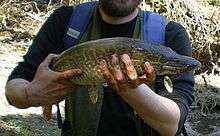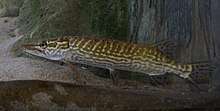Esox cisalpinus
Esox cisalpinus, the southern pike, is a species of freshwater fish known from central and northern Italy, southeastern France and Switzerland, and it might also occur in western Balkan.[1][2] It has traditionally been considered a southern European variant of the widespread northern pike (Esox lucius), but was described as a separate species in 2011.[3] The southern pike is an important species for recreational fisheries and for its role as a top predator in freshwater ecosystems.
| Southern pike | |
|---|---|
 | |
 | |
| Scientific classification | |
| Kingdom: | Animalia |
| Phylum: | Chordata |
| Class: | Actinopterygii |
| Order: | Esociformes |
| Family: | Esocidae |
| Genus: | Esox |
| Species: | E. cisalpinus |
| Binomial name | |
| Esox cisalpinus Bianco & Delmastro, 2011 | |
| Synonyms | |
|
| |
Taxonomy
Esox cisalpinus was distinguished from Esox lucius (northern pike) and described scientifically as a new species in 2011 independently by two research groups. The description by Bianco & Delmastro was printed earlier,[3] and the name Esox cisalpinus is therefore accepted, whereas the alternative name published somewhat later by Lucentini et al., Esox flaviae, is considered a junior synonym.[1]
Lucentini et al. explicitly tested the hypothesis that the different phenotypes of the pike, geographically isolated in Europe, represent two different evolutionary entities. They analysed phenotypic and genetic differences, e.g. in the skin colour pattern and in meristic characters such as the number of scales in the lateral line, which distinguish the two species. They applied a coalescent-based approach to mtDNA phylogeny and evaluated the degree of historical admixture, testing overall genetic differences from amplified fragment length polymorphism (AFLP). The Italian southern pike turned out distinct from the northern pike, whose range extends from central and northern Europe across Asia to North America.
The authors recommend stopping the stocking of pike in southern Europe using northern pike from other European countries, as this could greatly impact the survival of this newly discovered species in its native range.
References
- Lucentini, L.; Puletti, M. E.; Ricciolini, C.; Gigliarelli, L.; Fontaneto, D.; et al. (December 2, 2011). "Molecular and Phenotypic Evidence of a New Species of Genus Esox (Esocidae, Esociformes, Actinopterygii): The Southern Pike, Esox flaviae". PLoS ONE. 6 (12): e25218. doi:10.1371/journal.pone.0025218. PMC 3229480. PMID 22164201.
- Denys, Gaël Pierre Julien; Dettai, Agnès; Persat, Henri; Hautecœur, Mélyne; Keith, Philippe (2014). "Morphological and Molecular Evidence of Three Species of Pikes Esox spp. (Actinopterygii, Esocidae) in France, including the Description of A New Species". Comptes Rendus Biologies. 337 (9): 521–34. doi:10.1016/j.crvi.2014.07.002.
- Bianco, P. G. & Delmastro, G. B. (2011): Recenti novità tassonomiche riguardanti i pesci d’acqua dolce autoctoni in Italia e descrizione di una nuova specie di luccio. Researches on Wildlife Conservation (IGF publ.), 2 (suppl.): 1–13. PDF
External links
- Esox cisalpinus FishBase